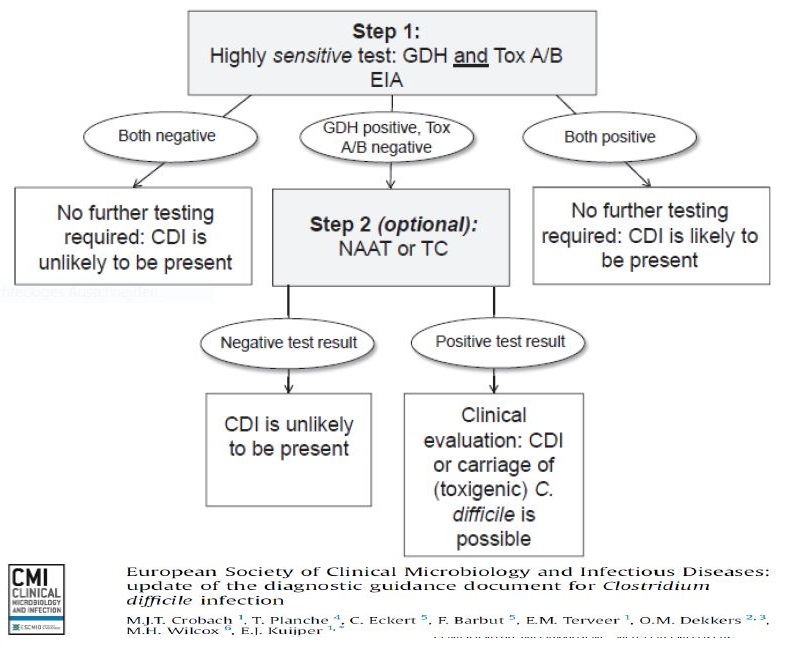Bacteriology
Clostridium difficile
Clostridium difficile (C. diff.) is a globally occurring bacterium found both in the environment and in the gut of healthy humans and animals. By prolonged intake of antibiotics, the intestinal flora is changed and the toxins of C. diff. can cause an intestinal inflammation with severe diarrhea. The most common C. diff. diseases occur in hospitalized patients. The highly infectious pathogen is excreted with the stool and even a small amount of germs is sufficient for infection. Not all individuals exposed to C. diff become ill. But a laboratory examination of the liquid stool from affected patients reveals whether C. diff. is the cause of the symptoms. The C. diff-specific enzyme glutamate dehydrogenase (GDH) is suitable as a screening test. It is produced by both toxigenic and non-toxigenic strains. The infection with pathogenic strains is proven by the detection of toxins (toxin A / B test). There are a wide range of diagnostic methods to detect C. diff infection.
- Rapid Test - fast and reliable results in up to 15 minutes
- ELISAs
- Nucleic Acid Amplification Technique
Bordetella pertussis
Whooping cough (pertussis) is a highly contagious bacterial respiratory tract infection caused by Bordetella pertussis. Pertussis usually occurs in children with paroxysmal convulsions in severe cough. The disease leads to high morbidity and mortality especially in children. Untreated, the disease may linger for weeks. But with early antibiotic treatment, the course is shortened and the contagiousness is limited. Depending on the stage of the disease, we offer the following diagnostics.
- Nucleic Acid Amplification Technique (first 2-3 weeks)
- Serodiagnosis (only after 3 weeks from the onset of cough)
Staphylococcus aureus
S. aureus, together with other bacteria, forms a protective umbrella on the skin of humans. If the germ is given the opportunity to get directly inside the body, this bacterium can lead to certain diseases. Skin inflammation or muscle diseases such as pyomyositis. However, in some cases, S. aureus can also cause life-threatening diseases such as blood poisoning, pneumonia, the so-called toxic syndrome (TTS) or endocarditis. In our portfolio you will find the following test for MRSA diagnostics.
- Nucleic Acid Amplification Technique
Chlamydophila pneumoniae (formerly Chlamydia pneumoniae)
Ch. Pneumoniae is a common pathogen of respiratory tract infections that may also cause chronic extrapulmonary disease. High infection (60-70% in adults) with long antibody persistence complicates the serological diagnosis of acute infections. Only high antibody levels or significant titer increases with corresponding clinical symptoms can be used diagnostically. Mycoplasmas are cell-wall-less bacteria that can lead to infectious diseases of the lung and the genitourinary tract. The transmission of M. pneumonieae occurs via droplet infection.
- Nucleic Acid Amplification Technique
- (Chlamydophila pneumoniae, Legionella pneumophila, Mycoplasma pneumoniae)
- Serodiagnostics
Mycoplasma pneumoniae
The bacterium Mycoplasma pneumoniae occurs exclusively in humans and causes various diseases, including atypical pneumonia. Similarly, a middle ear infection, inflammation of the larynx, a tracheobronchitis or meningitis can be caused by the pathogen. The transmission of the bacterium takes place by droplet infection. Particularly affected are children between the ages of 5 and 15 years.
- Rapid tests
- ELISA
- Nucleic Acid Amplification Technique
Chlamydia trachomatis
The bacterium is divided into several serovars that differ in the diseases they cause: Serovars A-C: conjunctivitis, trachoma; Serovars D-K: infections of the urogenital tract, the anal region, conjunctiva and the respiratory tract (newborns); Serovars L1-L3: Lymphogranuloma venereum (LGV). The transmission takes place via sexual contacts, smear infections or perinatally. The method of choice is detection with nucleic acid amplification tests.
- Rapid test
- Serodiagnostics
- Nucleic Acid Amplification Technique
Helicobacter Pylori
Since its discovery over 20 years ago by Marshall and Warren, Helicobacter pylori is now recognized as one of the most common and medically important pathogens worldwide. Helicobacter pylori has been firmly established as an etiologic agent in chronic gastritis and peptic ulcer disease, and has been associated with mucosa-associated lymphoid tissue lymphoma and gastric adenocarcinoma.
- ELISA
- Nucleic Acid Amplification Technique
Enterohämorrhagische E. COLI (EHEC)
Enterohemorrhagic E. coli (EHEC) have been isolated from patients who have hemorrhagic colitis and hemolyticuremic syndrome (HUS). To date, O157:H7 is the most frequently encountered EHEC strain in stools from these patients. This is probably due to the fact that conventional diagnostic strategies such as O157 latex agglutination assays rely on the unique sorbitol negative fermentation property of this strain. The major weakness in this approach is that at least 50 other EHEC serotypes have been reported to be associated with the development of hemorrhagic colitis and HUS.
- Rapid test
- ELISA
- Nucleic Acid Amplification Technique
There are several further parameters in our poduct portfolio like:
- B. henselae
- C. burnetii
- e. cchaffeensisH.inluenzae Typ B
- L.penuophila
- L.monocytogenes 1 und 4b
- Y.enterocolitica
- Campylobacter Antigen etc.

 Deutsch
Deutsch



